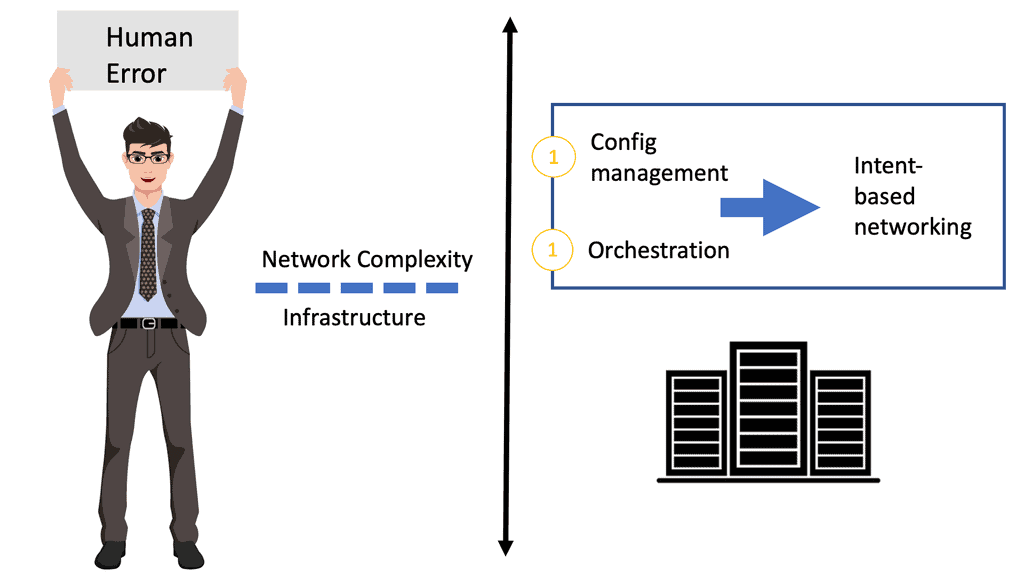Unlike traditional networking that relies on manual processes, intent-based networks use AI and automation to translate intention into network configuration. As such, they can automate time-consuming tasks and reduce errors.
Intent-based systems verify that policies are implemented and automatically enforce them. They also continuously monitor the network to ensure that it aligns with intent.
Intent-Based Architecture
Intent-based networking architecture is a network design approach that translates business intent into network policies. Business intent is the desired outcome for the network, as defined by the business.
Instead of manually configuring devices, network administrators can express their intent using a declarative language, and the IBN system will automatically configure and manage the network to achieve the desired outcomes. It could include improving application performance, reducing latency, or enhancing security. Network policy is a set of rules defining how the network should behave to achieve the business intent.
Network policies can be expressed in various ways, such as using declarative languages. Network telemetry is the data collected about the network to ensure it achieves the business intent. Network telemetry data can be collected from various sources, such as devices, sensors, and applications.
Intent-Based Networking
Intent-based networking (IBN) is a network management model that is a key component of a modern IT infrastructure. IBN enables networks to translate business intent into network configurations automatically. The goal is to make it easier for network managers to set and meet business objectives. This is accomplished by separating the network’s control and data planes and automating the configuration, management, testing, deployment, and operations of physical & virtual devices. Intent-based networking takes software-defined network management to the next level.
By focusing on the desired state of the network, which mirrors business objectives, and automating the decisions that bring you closer to that goal with each action, intent-based network architecture can provide a more responsive, agile and secure environment for your enterprise.
Previously, a network administrator would have to enter configurations into individual devices throughout the network manually. This is often tedious and time-consuming. However, an IT generalist or business owner can send a request to the network that it will automatically interpret and respond to with an intent-based system.
The network will determine the best way to fulfill that request while complying with previously deployed policies. It will also perform self-checks and correct errors as they occur to ensure that the network is performing as expected.
This is where an IBN system shines. Intent-based systems are also vendor-agnostic and portable, meaning they don’t need a deep understanding of the specific technology used on your network. The intent is the input, not the underlying infrastructure and system implementation. This makes scaling and maintaining the method easier as new technologies are adopted. Ultimately, it reduces risk and costs by eliminating manual input while automating all changes to your network.
Network Orchestration
Network orchestration is the software that automates the translation of business intent into network policy and the implementation of network policy across the network. Network orchestration tools use a variety of algorithms and techniques to ensure that the network is always configured in a way that aligns with the business intent.
With this system, network managers can tell the network what they want it to accomplish. The software then translates these business goals into network configurations to achieve those goals.
The network can even maintain these desired outcomes in the face of device failures and outages by reconfiguring other devices.
This approach reduces the manual work that network administrators must do. It also increases the speed at which a network can meet business needs. Moreover, it improves security and optimizes network performance.
Network Automation
Network automation uses programmable logic to manage network devices and software components. This approach allows Network Operations (NetOps) teams to configure, scale, protect, and integrate network infrastructure and application services faster than possible by manual processes. It also reduces the likelihood of human errors, which are the leading cause of data breaches, and makes it easier to meet compliance requirements.
Network administrators can leverage tools built into the network platform or third-party software to create and execute automated scripts. These scripts are based on common “if X, then Y” decision statements that allow them to manage and schedule network automation. Many modern SDN platforms also offer a set of commonly used and pre-built automation tasks that can be easily adjusted and scheduled.
The ability to automatically detect and correct issues reduces downtime and improves the end-user experience. It also frees up time and resources for other tasks, increasing efficiency.
Conclusion
Intent-based networking enables CSPs to take a broader view of the network and how it relates to their business strategy. For example, if an application does not meet a service level agreement, the network can automatically adjust as best it can to bring performance back in line. This is akin to a self-driving car taking the driver’s intent of ‘take me home’ and finding the fastest and most efficient route.
